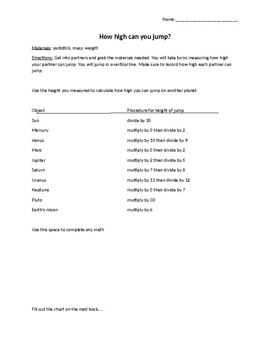How high can you jump on other planets?
Elizabeth Lund
1 Follower
Grade Levels
6th - 12th, Homeschool
Subjects
Resource Type
Standards
NGSSHS-ESS1-6
NGSSHS-ESS1-4
Formats Included
- Word Document File
Pages
2 pages
Elizabeth Lund
1 Follower
Description
This is a great lab that allows kids to be a little bit more active. It does involve a little bit of math but is very easy (especially with you calculator if you let them).
Total Pages
2 pages
Answer Key
Does not apply
Teaching Duration
50 minutes
Report this resource to TPT
Reported resources will be reviewed by our team. Report this resource to let us know if this resource violates TPT’s content guidelines.
Standards
to see state-specific standards (only available in the US).
NGSSHS-ESS1-6
Apply scientific reasoning and evidence from ancient Earth materials, meteorites, and other planetary surfaces to construct an account of Earth’s formation and early history. Emphasis is on using available evidence within the solar system to reconstruct the early history of Earth, which formed along with the rest of the solar system 4.6 billion years ago. Examples of evidence include the absolute ages of ancient materials (obtained by radiometric dating of meteorites, moon rocks, and Earth’s oldest minerals), the sizes and compositions of solar system objects, and the impact cratering record of planetary surfaces.
NGSSHS-ESS1-4
Use mathematical or computational representations to predict the motion of orbiting objects in the solar system. Emphasis is on Newtonian gravitational laws governing orbital motions, which apply to human-made satellites as well as planets and moons. Mathematical representations for the gravitational attraction of bodies and Kepler’s Laws of orbital motions should not deal with more than two bodies, nor involve calculus.



